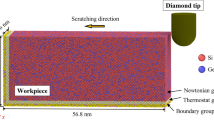Abstract
Insights into the interaction between laser and energetic materials offer possibility of manipulating and initiating explosives in a more precise, controllable way. Herein, we investigate the interaction between laser and cyclotrimethylene trinitramine (RDX) energetic crystals with scratch defects in the framework of three-dimensional finite difference time domain. Modulation effects on the hot spot formations have been explored for single scratch of parabolic/triangular geometries as well as two-scratch combination in parallel and intersecting configurations. The calculation results disclose that for single scratch, the width of scratch affects more on the light intensification than its depth. Meanwhile, scratch defects of triangular geometry exhibit stronger modulation effect than the parabolic ones. For two-scratch combinations, including both parallel and intersecting configurations, a coupling effect is found to promote generation of hot spots under laser irradiation. In particular, the triangular & triangular interaction presents largest enhancement on light intensification among diverse configurations. It also reveals that RDX crystals are more easily initiated when the intervals between two parallel scratches are appropriate (λ–4λ), or the intersecting scratches are perpendicular with each other. This work offers a primary inspiration for better understanding the formation of hot spots under laser irradiation and provides practical guideline for the surface quality managements of explosive materials.











Similar content being viewed by others
References
Bowden FP, Yoffe AD (1958) Fast reactions in solids. Butterworths Scientific Publications, London
Levesque G, Vitello P, Howard WM (2013) Hot-spot contributions in shocked high explosives from mesoscale ignition models. J Appl Phys 113:233513
LaBarbera DA, Zikry MA (2013) The effects of microstructural defects on hot spot formation in cyclotrimethylenetrinitramine-polychlorotrifluoroethylene energetic aggregates. J Appl Phys 113:243502
You S, Chen M-W, Dlott DD, Suslick KS (2015) Ultrasonic hammer produces hot spots in solids. Nat Commun 6:6581
Warrier M, Pahari P, Chaturvedi S (2015) Molecular dynamics analysis of the transient temperature increase at void locations in shocked materials: RDX and Cu. J Mol Model 21:192
Ng WL, Field JE, Hauser HM (1986) Thermal, fracture, and laser-induced decomposition of pentaerythritol tetranitrate. J Appl Phys 59:3945–3952
Hagan JT, Chaudhri MM (1981) Low energy laser initiation of single crystals of β-lead azide. J Mater Sci 16:2457–2466. doi:10.1007/BF01113582
Ramaswamy AL, Field JE (1996) Laser-induced ignition of single crystals of the secondary explosive cyclotrimethylene trinitramine. J Appl Phys 79:3842–3847
Chen M-W, You S, Suslick KS, Dlott DD (2014) Hot spot generation in energetic materials created by long-wavelength infrared radiation. Appl Phys Lett 104:061907
Langer G, Eisenreich N (1999) Hot spots in energetic materials, propellants explos. Pyrotech. 24:113–118
Field JE (1992) Hot spot ignition mechanisms for explosives. Acc Chem Res 25:489–496
Bowden FP, Yoffe AD (1952) Initiation and growth of explosion in liquids and solids. Cambridge University Press, Cambridge
Elban WL, Hoffsommer JC, Armstrong RW (1984) X-ray orientation and hardness experiments on RDX explosive crystals. J Mater Sci 19:552–566. doi:10.1007/BF02403243
Sharma J, Hoover SM, Coffey CS, Tompa AS, Sandusky HW, Armstrong RW, Elban WL (1998) Structure of crystal defects in damaged RDX as revealed by an AFM. AIP Conf Proc 429:563–566
Kuklja MM, Stefanovich EV, Kunz AB (2000) An excitonic mechanism of detonation initiation in explosives. J Chem Phys 112:3417–3423
Bouma RHB, Duvalois W, Van Der Heijden AEDM (2013) Microscopic characterization of defect structure in RDX crystals. J Microsc 252:263–274
Yan Z, Zhang C, Liu W, Li J, Huang M, Wang X, Zhou G, Tan B, Yang Z, Li Z, Li L, Yan H, Yuan X, Zu X (2016) Ultraviolet laser-induced ignition of RDX single crystal. Sci Rep 6:20251
Brown JA, Zikry MA (2015) Effect of microstructure on the coupled electromagnetic-thermo-mechanical response of cyclotrimethylenetrinitramine-estane energetic aggregates to infrared laser radiation. J Appl Phys 118:124902
Lee Perry W, Gunderson JA, Glover BB, Dattelbaum DM (2011) Electromagnetically induced localized ignition in secondary high explosives: experiments and numerical verification. J Appl Phys 110:034902
Zhang CL, Yuan XD, Xiang X, Wang ZG, Liu CM, Li L, He SB, Zu XT (2012) Rear-surface light intensification caused by a Hertzian-conical crack in 355-nm silica optics. Chin Phys B 21:094213
Yang L, Xiang X, Miao XX, Li L, Yuan XD, Yan ZH, Zhou GR, Lv HB, Zheng WG, Zu XT (2016) Numerical simulation of modulation to incident laser by submicron to micron surface contaminants on fused silica. Chin Phys B 25:014210
Cheng J, Chen M, Liao W, Wang H, Xiao Y, Li M (2013) Fabrication of spherical mitigation pit on KH2PO4 crystal by micro-milling and modeling of its induced light intensification. Opt Express 21:16799–16813
Werner GR, Bauer CA, Cary JR (2013) A more accurate, stable, FDTD algorithm for electromagnetics in anisotropic dielectrics. J Comput Phys 255:436–455
Yee K (1966) Numerical solution of initial boundary value problems involving Maxwell’s equations in isotropic media. IEEE Trans Antenna Propag 14:302–307
Yan Z, Zhang C, Yan H, Li Z, Li L, Huang M, Tan B, Yuan X (2014) Defects-induced hot spots in TATB. Adv Condens Matter Phys 2014:219547
Raha K, Chhabra JS (1993) Static charge development and impact sensitivity of high explosives. J Hazard Mater 34:385–391
Berenger JP (1994) A perfectly matched layer for the absorption of electromagnetic waves. J Comput Phys 114:185–200
Deng HX, Zu XT, Xiang X, Sun K (2010) Quantum theory for cold avalanche ionization in solids. Phys Rev Lett 105:113603
Acknowledgements
This study was financially supported by the NSAF Joint Foundation of China (No. U1330108), the National Natural Science Foundation of China (Nos. 11304209, 11372289), the Project Sponsored by the China Scholarship Council (No. 201506075044), the Fundamental Research Funds for the Central Universities (ZYGX2014J035), and the Start Science Foundation of UESTC (No. Y02002010401084)
Author information
Authors and Affiliations
Corresponding authors
Ethics declarations
Conflict of interest
The authors declare that they have no conflict of interest.
Rights and permissions
About this article
Cite this article
Yan, Z., Liu, W., Zhang, C. et al. Scratch defects modulated hot spots generation in laser irradiated RDX crystals: a 3D FDTD simulation. J Mater Sci 51, 8812–8823 (2016). https://doi.org/10.1007/s10853-016-0086-2
Received:
Accepted:
Published:
Issue Date:
DOI: https://doi.org/10.1007/s10853-016-0086-2




